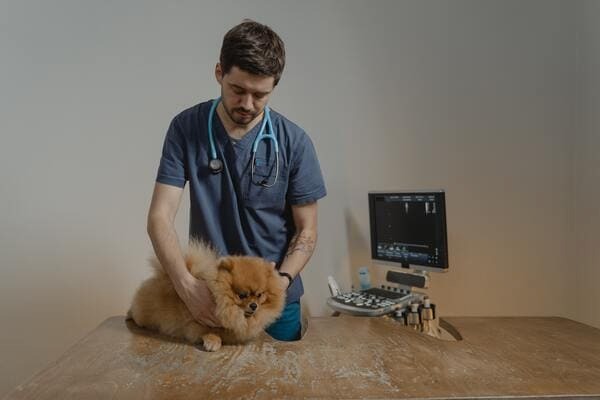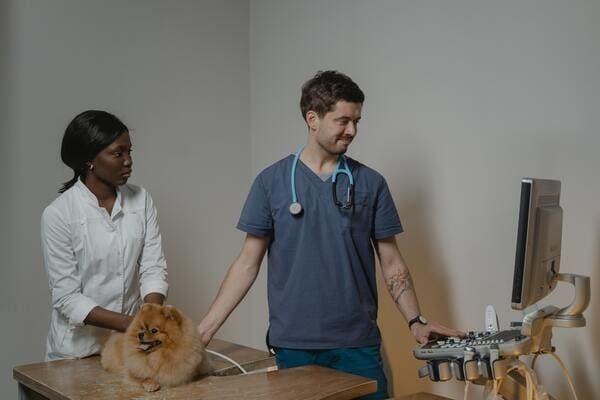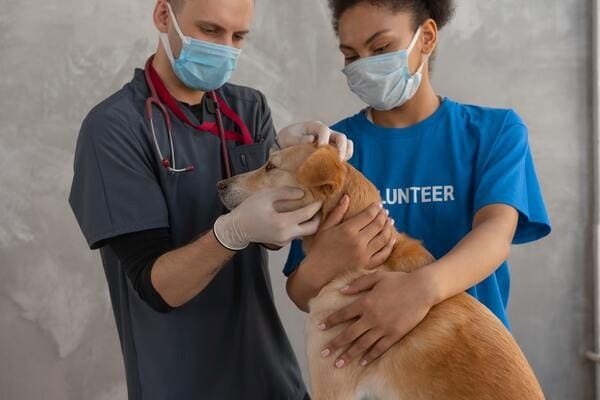

Why Is Veterinary Care So Expensive?
Animalia explores the sometimes surprisingly high costs of pet care. If you’ve ever wondered how your vet bills got to be so high, read on.

Writer Animalia Team
6 min read

Many pet owners may pause before pursuing medical attention for their pets, with the substantial expense of veterinary bills often presenting a daunting aspect. The question arises: What contributes to the high costs of vet bills? Let’s delve into some of the reasons behind this.
The rise in veterinary costs
Dogs are part of the family, but keeping them healthy is becoming increasingly expensive. The cost of pet food is up 25% since 2020, and vet care costs have increased by nearly 11% from July 2022 to July 2023, according to the Bureau of Labor Statistics’ Consumer Price Index. According to a recent survey by the USA Today, the majority of people surveyed (91%) said the cost of pet care led them to experience some degree of financial stress this year.
According to research conducted by LendingTree, at least 40% of US pet owners aren’t financially prepared to cover a veterinary emergency, therefore, most of these pet owners are likely (and willing) to end up in debt because of veterinary expenses. In fact, at least 70% of pet owners have noticed a rise in their pet care expenses and 26% have confessed to struggling to afford pet care during these months.
Multiple factors are affecting veterinary costs, including inflation, higher levels of care and longer lifespan. Let’s explore the most pivotal ones.
Technological advances and the integration of human medicine into the realm of veterinary care
Trends in human medicine have seamlessly transitioned into the realm of veterinary care. Cutting-edge technologies originally developed for human medical applications are now being adapted to enhance the diagnosis, treatment, and overall well-being of animals. From advanced diagnostic imaging techniques like MRI and CT scans to sophisticated surgical procedures and therapeutic interventions, pets are benefiting from the cross-pollination of medical innovations.
In the past, for example, a cancer diagnosis for animals typically resulted in humane euthanasia. However, contemporary veterinary medicine now offers the same diagnostic tools and therapeutic interventions used for human cancer treatment, responding to the increasing demand for such services from pet owners. Complementary therapies, including acupuncture, laser therapy, and rehabilitation therapy, have become standard offerings at many veterinary practices, no longer limited to large teaching hospitals. The emphasis on improving an animal’s quality of life has become a paramount concern for the majority of pet owners. However, the flip side is that pet owners often find themselves incurring higher expenses due to the implementation of these advanced and more effective veterinary practices.

The inflation: Increased overhead costs
The most substantial surge in inflation in four decades in the United States has escalated the expenses associated with veterinary care for your pets. Financial experts are advising veterinary practices to implement quarterly fee increases to proactively manage the impact of inflation and sustain their operations. The spike in costs has created additional challenges for both veterinary clinics and pet owners, compounding the difficulties of recovering from the repercussions of the Covid-19 pandemic. Veterinary medicine, being a labor-intensive service, faces the strain of employee salaries accounting for nearly 50% of clinic operational costs. Against the backdrop of national wage increases at the swiftest pace in decades, many clinic owners find themselves compelled to offer higher wages to attract and retain employees. Consequently, these wage hikes are commonly transferred to pet owners in the form of increased service prices.

Pet parents are willing to pay more
Pet parents are increasingly willing to allocate more resources for their furry companions. As cherished members of the family, pets hold a special place in our hearts. The human-pet bond, which goes beyond unconditional love and companionship, colors every choice people make for their pets, including veterinary care. The pet industry is evolving beyond merely humanizing pets; instead, they are now universally embraced as integral components of a pet owner’s lifestyle. Regardless of the driving force behind the augmented expenditures on pets—whether it’s improved nutrition, enhanced healthcare, increased indulgence, or advanced technology—one undeniable fact remains: pet owners prioritize ensuring longer, healthier lives for their beloved animal companions.
Pets live longer
Partially because of this commitment to routine care, animals are living longer. A few decades ago, a dog or cat that lived to be 8 or 10 was considered old. According to an American Veterinary Medical Association study, dog life expectancy is now up to 15-20 years old. This means diseases that are diagnosed infrequently in younger animals, such as cancer, are being diagnosed more often.
As dogs and cats live longer, they get to spend more and more quality time with their loving owners. Unfortunately, even a relatively healthy dog or cat will present their owner with a world of expenses over their lifetime. More time together, means more spending in addition to all the good stuff. Also, pets living longer lives generally means we start to see the consequences of old age which require veterinary treatment.
Education and training
The expenses associated with veterinary services are also influenced by the financial burden veterinarians carry due to their education. In essence, the depth of the financial commitment incurred during their education plays a role in determining the costs of their services. Veterinarians undergo rigorous education and training to attain professional licensure, involving a four-year undergraduate degree followed by four years of veterinary school. The substantial investment of time and resources in their education contributes to the overall expenses they must recoup, and these costs are frequently mirrored in the fees associated with veterinary services.

Pet insurance may be the answer
Pet insurance is designed to help cover some of the out-of-pocket expenses associated with veterinary care for your beloved pet. It provides a kind of financial safety net, offering peace of mind and assurance that you’ll never be totally blindsided by veterinary expenses. Enrollment remains low, however, as many pet owners are not aware about the potential savings presented by insurance. Some don’t know it exists at all, though a growing number of employers are including it as a benefit for their teams.
Purchasing pet insurance early and thoroughly researching your options helps ensure you’re prepared to cover the broadest possible range of healthcare costs, get reimbursed for the most possible expenses, and keep your pet happy and healthy for as long as possible. Get a quote today to learn more about how a policy from Animalia can help you save on the cost of care and do more for your pet.
Get a quote today to learn more about how a policy from Animalia can help you save on the cost of care and do more for your pet.
Sources:





We offer the most
comprehensive coverage
out there
car with a spare tire for life’s bumps.
Having Animalia is like a pimped-out
Rolls Royce with a swimming pool
in the trunk.



Get your pet insurance quote
Pet type
- Dog
- Cat
What is your pet's name?
Zip code





